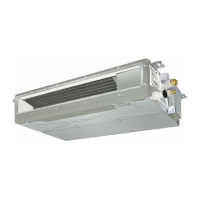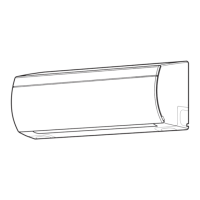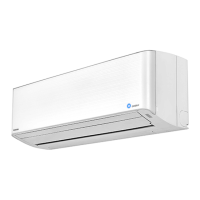Do you have a question about the Toshiba RAS-M16UKV-E3 and is the answer not in the manual?
Detailed technical specifications for indoor and outdoor units.
Performance specifications for various indoor/outdoor unit combinations.
Electrical data for outdoor units, including power supply, compressor, and fan motor details.
Safety guidelines for installation and servicing of R410A systems.
Guidelines for selecting and installing refrigerant piping materials and joints.
Lists tools exclusive for R410A and general tools required for installation.
Step-by-step guide for recharging refrigerant into the system.
Details on brazing filler materials, flux, and brazing procedures.
Exploded view and key dimensions of the indoor unit assembly.
Exploded view and key dimensions of the outdoor unit assembly.
Wiring diagram illustrating connections for the indoor unit components.
Wiring diagram for the outdoor unit, including inverter assembly components.
List of electrical parts used in the indoor unit with their specifications.
List of electrical parts used in the outdoor unit with their specifications.
Diagrams illustrating refrigerant flow for cooling and heating operations.
Operational data tables for cooling mode, detailing performance under various conditions.
Operational data tables for heating mode, detailing performance under various conditions.
Block diagram showing the control functions and signals of the indoor unit.
Block diagram illustrating the control functions of the outdoor unit's inverter assembly.
General overview of the air conditioner's control system and operation.
Explanation of how the unit operates in cooling mode, including capacity control.
Details on the dry operation mode, focusing on dehumidification.
Explanation of how the unit operates in heating mode, including defrost control.
Information on temporary auto and cooling operations via the remote.
How to set up and use the automatic restart function after power loss.
Explanation of the remote control's buttons, functions, and display indicators.
Critical safety warnings and precautions to follow during installation.
Lists specific tools required for R410A installation and servicing.
Procedures for installing the indoor unit, including mounting and piping.
Recommendations for choosing an appropriate installation location for the indoor unit.
Steps for cutting wall holes and mounting the indoor unit installation plate.
Instructions for connecting the electrical wiring to the indoor unit.
Procedures for forming and installing refrigerant piping and drain hoses.
Instructions for ensuring correct drainage from the indoor unit.
Guide to setting the remote controller selector switch for multi-room installations.
Procedures for verifying the installation and performing test operations.
Procedures for installing the outdoor unit, including placement and securing.
Instructions for connecting refrigerant pipes, including flaring and tightening.
General guidelines for installing the outdoor unit, including placement and fixing.
Steps for evacuating air and moisture from the refrigerant system using a vacuum pump.
Instructions for connecting the power supply and wiring the unit.
Specific checks and tests for R410A systems after installation.
Procedure to check for miswiring or mispiping using LED indicators.
Basic checks to confirm power supply and voltage before troubleshooting.
Initial troubleshooting steps involving LED indicators and basic checks.
Guide to interpreting indoor unit LED blinking patterns for self-diagnosis.
How to access and interpret self-diagnosis check codes via the remote control.
Safety precautions to be observed when performing servicing or repairs.
Symptom-based troubleshooting flowcharts for various issues.
Troubleshooting steps for failures related to interconnecting and serial signal wires.
Guide to interpreting outdoor unit LED patterns for self-diagnosis.
Flowchart for diagnosing issues within the outdoor unit's inverter assembly.
Simple procedures to check the functionality of major components like P.C. boards and motors.
Methods for checking electrolytic capacitors, converter modules, and IGBT modules.
Steps to determine if the outdoor fan motor is functioning correctly.
Step-by-step guide for replacing main parts of the indoor unit.
Procedure for replacing the microcomputer unit.
Step-by-step guide for detaching and replacing main parts of the outdoor unit.
Exploded view and list of parts for the indoor unit.
Exploded view and list of parts for the outdoor unit.
Layout diagrams for the P.C. boards used in the system.
Detailed technical specifications for indoor and outdoor units.
Performance specifications for various indoor/outdoor unit combinations.
Electrical data for outdoor units, including power supply, compressor, and fan motor details.
Safety guidelines for installation and servicing of R410A systems.
Guidelines for selecting and installing refrigerant piping materials and joints.
Lists tools exclusive for R410A and general tools required for installation.
Step-by-step guide for recharging refrigerant into the system.
Details on brazing filler materials, flux, and brazing procedures.
Exploded view and key dimensions of the indoor unit assembly.
Exploded view and key dimensions of the outdoor unit assembly.
Wiring diagram illustrating connections for the indoor unit components.
Wiring diagram for the outdoor unit, including inverter assembly components.
List of electrical parts used in the indoor unit with their specifications.
List of electrical parts used in the outdoor unit with their specifications.
Diagrams illustrating refrigerant flow for cooling and heating operations.
Operational data tables for cooling mode, detailing performance under various conditions.
Operational data tables for heating mode, detailing performance under various conditions.
Block diagram showing the control functions and signals of the indoor unit.
Block diagram illustrating the control functions of the outdoor unit's inverter assembly.
General overview of the air conditioner's control system and operation.
Explanation of how the unit operates in cooling mode, including capacity control.
Details on the dry operation mode, focusing on dehumidification.
Explanation of how the unit operates in heating mode, including defrost control.
Information on temporary auto and cooling operations via the remote.
How to set up and use the automatic restart function after power loss.
Explanation of the remote control's buttons, functions, and display indicators.
Critical safety warnings and precautions to follow during installation.
Lists specific tools required for R410A installation and servicing.
Procedures for installing the indoor unit, including mounting and piping.
Recommendations for choosing an appropriate installation location for the indoor unit.
Steps for cutting wall holes and mounting the indoor unit installation plate.
Instructions for connecting the electrical wiring to the indoor unit.
Procedures for forming and installing refrigerant piping and drain hoses.
Instructions for ensuring correct drainage from the indoor unit.
Guide to setting the remote controller selector switch for multi-room installations.
Procedures for verifying the installation and performing test operations.
Procedures for installing the outdoor unit, including placement and securing.
Instructions for connecting refrigerant pipes, including flaring and tightening.
General guidelines for installing the outdoor unit, including placement and fixing.
Steps for evacuating air and moisture from the refrigerant system using a vacuum pump.
Instructions for connecting the power supply and wiring the unit.
Specific checks and tests for R410A systems after installation.
Procedure to check for miswiring or mispiping using LED indicators.
Basic checks to confirm power supply and voltage before troubleshooting.
Initial troubleshooting steps involving LED indicators and basic checks.
Guide to interpreting indoor unit LED blinking patterns for self-diagnosis.
How to access and interpret self-diagnosis check codes via the remote control.
Safety precautions to be observed when performing servicing or repairs.
Symptom-based troubleshooting flowcharts for various issues.
Troubleshooting steps for failures related to interconnecting and serial signal wires.
Guide to interpreting outdoor unit LED patterns for self-diagnosis.
Flowchart for diagnosing issues within the outdoor unit's inverter assembly.
Simple procedures to check the functionality of major components like P.C. boards and motors.
Methods for checking electrolytic capacitors, converter modules, and IGBT modules.
Steps to determine if the outdoor fan motor is functioning correctly.
Step-by-step guide for replacing main parts of the indoor unit.
Procedure for replacing the microcomputer unit.
Step-by-step guide for detaching and replacing main parts of the outdoor unit.
Exploded view and list of parts for the indoor unit.
Exploded view and list of parts for the outdoor unit.
Layout diagrams for the P.C. boards used in the system.
| Power Supply | 220-240V, 50Hz |
|---|---|
| Refrigerant | R410A |
| Seasonal Energy Efficiency Ratio (SEER) | 6.10 |
| Indoor Unit Noise Level | 27-45 dB(A) |
| Noise Level (Indoor Unit) | 27-45 dB(A) |











